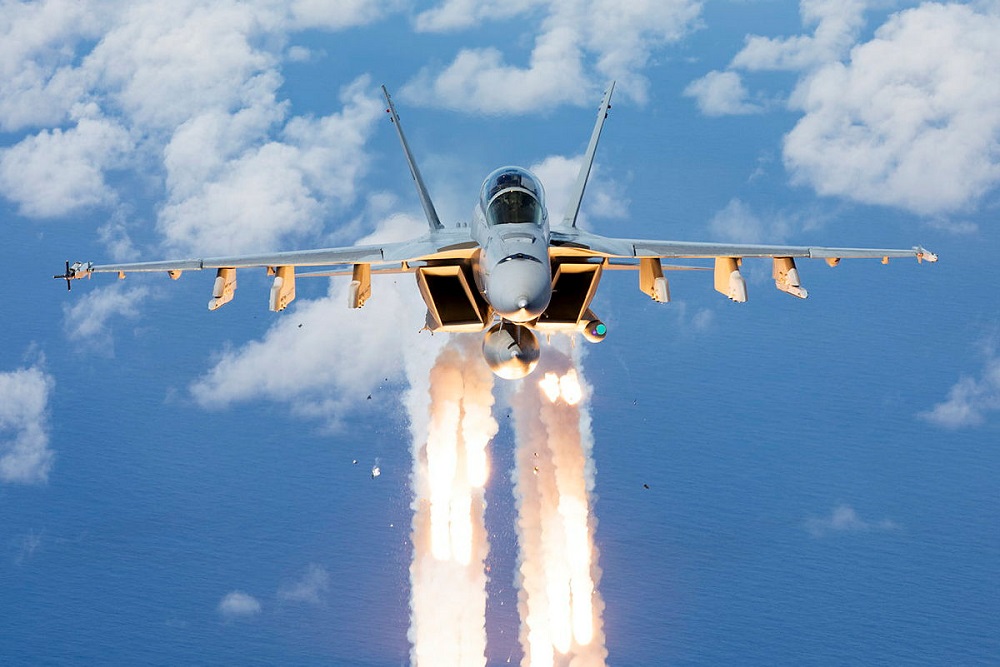
The Royal Australian Air Force says it will fly its 24 F/A-18F Super Hornets through to the mid-2030s rather than retiring them by 2027 as had been intended. And it will open up a competition for a replacement rather than necessarily acquiring additional F-35A Lightning IIs. It seems likely that the Block II Super Hornets will be upgraded to full Block III configuration to maximise their capability.
The operational extension has clearly has been under consideration for some time. Most recently, the defence portfolio budget statement made clear that:
During 2023–24, F/A-18F and EA-18G aircraft are scheduled to undergo planned capability upgrades as part of the US Navy-managed Spiral Upgrade Program to ensure the platform’s ongoing lethality and survivability in a contested air combat environment, and to maintain configuration alignment with the United States Navy.
The upgrade will modernise the F/A-18F cockpit with new widescreen displays called the advanced cockpit system or ACS, and incorporate tactical targeting network technology (TTNT) and a distributed targeting processor network (DTP-N) as capable as those in the F-35A. The upgrade is likely to be done in Australia.
The Block III brings a new infrared search and track (IRST) capability to detect targets at greater range without using active radar, as well as enhanced satellite communications, and new fuselage coatings to reduce the radar signature. The airframes are upgraded to extend their service life from 6,000 to 10,000 hours.
The DTP-N and TTNT will give the F/A-18F a rapid growth capability in terms of avionics, computing, and systems architecture. The Block III aircraft can more easily undertake crewed–autonomous teaming with the MQ-28A Ghost Bat, which the defence strategic review said would be further developed under a collaborative program with the US. The new configuration will also make it easier for the aircraft to network with other weapons and platforms.
Australia’s Super Hornets will remain a potent capability, especially when teamed with the Ghost Bat and as a platform for delivering long-range standoff weapons such as the AGM-158C LRASM and AGM-158B JASSM-ER. An air concept of operations could see the F-35A acting as a forward sensor, exploiting its stealth to avoid detection, and then cueing targeting information to upgraded Super Hornets while EA-18G Growlers stop an adversary from using radar systems or sending information to air defences and opposing fighters. A team could also include other specialised electronic warfare aircraft, such as the MC-55 Peregrine and the E-7A Wedgetail, and tankers.
So, what does a force look like beyond the mid-2030s?
The RAAF must continue to develop as an air and space force, with advanced space capabilities playing a key role in command and control and battlespace awareness through intelligence, surveillance and reconnaissance systems. But these projects must avoid the trap of relying only on a small number of high-end, costly and exquisite satellites that are increasingly vulnerable to Chinese and Russian counterspace capabilities.
Defence must complement these high-end capabilities with a ‘small, cheap and many’ approach based on large constellations of small satellites produced locally and ideally launched from Australia on locally developed launch vehicles, enabling rapid augmentation and reconstitution of space capabilities in a crisis. That would make space capabilities more resilient against growing counterspace threats. Then air combat capabilities such as the F/A-18Fs, F-35As and Ghost Bats can more assuredly depend on sovereign and allied space capabilities including positioning, navigation, and timing services from global navigation satellite systems.
It would be a mistake to assume that small numbers of large satellites are somehow immune to attack, and the value of larger constellations of small satellites has been clearly demonstrated by SpaceX’s Starlink supporting Ukrainian operations despite ineffectual Russian attempts to jam it.
Crewed–autonomous teaming needs to be embraced and Defence should support the development and fund the acquisition of sufficient Ghost Bats to complement crewed platforms. The government has indicated that it supports developing a ‘Block 2’ Ghost Bat. That fits neatly into US efforts to develop crewed–autonomous teaming as part of future air combat capabilities including the US Air Force’s Next Generation Air Dominance (NGAD) project.
The RAAF should join US and other allied sixth-generation projects early. While the F-35A will continue to fly into the 2040s, it would be a missed opportunity for the RAAF to simply rely on that aircraft and ignore important developments in NGAD, the US Navy’s F/A-XX program and the UK-led Global Combat Air Programme.
RAAF chief Air Marshal Robert Chipman has said: ‘We will look at the F-35 and we’re very, very comfortable and very happy with the capability of the F-35. But it would be remiss of me not to look at what else is available for us to replace our Super Hornets in the future.’
With the defence strategic review emphasising ‘impactful projection’ as a key requirement for the ADF’s approach to a ‘focused force’, it’s important for the RAAF to emphasise long-range air dominance and multirole air capability in the post–Super Hornet era. NGAD is almost a return to the days of the interceptor, with range, payload and low observability likely features. Given the vast distances across Australia’s strategic environment, NGAD’s likely supercruise capability at high altitude will enable the RAAF to exploit ‘near space’ for the first time. From there, advanced sensors, communications and weapons such as beyond-visual-range air-to-air missiles like the AIM-260 joint advanced tactical missile can be best used for long-range air defence.
Defence white papers, and the recent strategic review, have emphasised strike missions for the RAAF, but air dominance will become increasingly important, especially to counter cruise missiles or forward-deployed combat aircraft and loitering munitions. Having the upgraded F/A-18F, together with the F-35A, clearly opens up opportunities for advanced crewed–autonomous teaming with platforms such as the Ghost Bat and places Australia in a good position to consider a sixth-generation future force with advanced, high-performance crewed aircraft, standoff weapons, autonomous systems and space capabilities at its heart.

